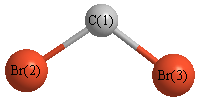Jump to
S2C1
Energy calculated at CCSD(T)=FULL/6-31G*
| | hartrees |
|---|
| Energy at 0K | -5177.965463 |
| Energy at 298.15K | -5177.970441 |
| HF Energy | -5177.522395 |
| Nuclear repulsion energy | 323.486036 |
The energy at 298.15K was derived from the energy at 0K
and an integrated heat capacity that used the calculated vibrational frequencies.
Geometric Data calculated at CCSD(T)=FULL/6-31G*
Point Group is C2v
Cartesians (Å)
| Atom |
x (Å) |
y (Å) |
z (Å) |
|---|
| C1 |
0.000 |
0.000 |
1.023 |
| Br2 |
0.000 |
1.562 |
-0.088 |
| Br3 |
0.000 |
-1.562 |
-0.088 |
Atom - Atom Distances (Å)
| |
C1 |
Br2 |
Br3 |
| C1 | | 1.9164 | 1.9164 |
Br2 | 1.9164 | | 3.1238 | Br3 | 1.9164 | 3.1238 | |
 More geometry information
More geometry information
Calculated Bond Angles
| atom1 |
atom2 |
atom3 |
angle |
|
atom1 |
atom2 |
atom3 |
angle |
| Br2 |
C1 |
Br3 |
109.179 |
|
Electronic energy levels
Charges, Dipole, Quadrupole and Polarizability
Jump to
S1C1
Energy calculated at CCSD(T)=FULL/6-31G*
| | hartrees |
|---|
| Energy at 0K | -5177.941804 |
| Energy at 298.15K | -5177.946821 |
| HF Energy | -5177.539340 |
| Nuclear repulsion energy | 315.369900 |
The energy at 298.15K was derived from the energy at 0K
and an integrated heat capacity that used the calculated vibrational frequencies.
Geometric Data calculated at CCSD(T)=FULL/6-31G*
Point Group is C2v
Cartesians (Å)
| Atom |
x (Å) |
y (Å) |
z (Å) |
|---|
| C1 |
0.000 |
0.000 |
0.755 |
| Br2 |
0.000 |
1.660 |
-0.065 |
| Br3 |
0.000 |
-1.660 |
-0.065 |
Atom - Atom Distances (Å)
| |
C1 |
Br2 |
Br3 |
| C1 | | 1.8509 | 1.8509 |
Br2 | 1.8509 | | 3.3193 | Br3 | 1.8509 | 3.3193 | |
 More geometry information
More geometry information
Electronic energy levels
Charges, Dipole, Quadrupole and Polarizability
